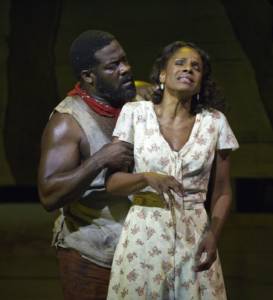article
Bad Love on Stage and Screen – Educational Toolkit Extension
AUG 19, 2015

(Joe Tippett and Jessie Mueller in Waitress)
“I feel nothing like affection. Maybe that man smothered all the affection outta me.”
Jenna, the main character of Waitress, admits that she has been hurt physically and emotionally by her husband Earl, though it is not easy for her to escape Earl’s physical, emotional, and financial control of her. Sadly, feeling stuck in a relationship like Jenna’s happens frequently to many men and women. Theater and film have found innovative, entertaining, and poignant ways of portraying real-life issues, feelings and relationships over the decades.
Today, performance remains a vital tool in spreading awareness, compassion, and understanding when confronting problematic issues like domestic abuse, which can take many forms, both physical and emotional. Victims in these situations are often advised to leave their abusive partner, but as Jenna and Earl’s relationship shows, it’s not always that easy. Domestic abuse unfortunately is a very real issue: statistics obtained from The National Coalition Against Domestic Violence show that intimate partner violence accounts for 15% of all violent crime and 4 in 10 men and women have experienced at least one form of coercive control by an intimate partner in their lifetime.
To get an idea about how love goes bad in the American Musical, take a look at Jenna in Waitress (listen to “She Used to Be Mine“) and see below for information on two more female lead characters from previous decades: Audrey from the film-turned-musical-turned-film Little Shop of Horrors(1986) and Bess from the Gershwins’ classic musical Porgy and Bess(1934).
Porgy and Bess
Porgy and Bess (1934) is the epic, sweeping opera of the passionate romance between the beggar Porgy and the troubled outcast Bess, and how it affects their close-knit community. While their relationship seems happy, storm clouds gather and suspicion mounts as old haunts, including Bess’s intimidating, abusive lover Crown, return. Bess is faced with a choice: does she stay with a man who loves her, or fall back on her old ways? Music by George Gershwin, Libretto by DuBose Heyward and Ira Gershwin.

(Phillip Boykin and Audra McDonald in A.R.T.’s 2011 production of The Gerswhins’ Porgy and Bess)
“What You Want With Bess?”
What you want wid Bess?
She’s gettin’ ole now;
Take a fine young gal
For to satisfy Crown.
Look at this chest
An’ look at these arms you got.
You know how it always been with me,
These five years I been yo’ woman,
You could kick me in the street,
Then when you wanted me back,
You could whistle, an’ there I was
Back again, lickin’ yo’ hand.
There’s plenty better lookin’ gal than Bess
Can’ you see, I’m with Porgy,
Now and forever
I am his woman, he would die without me.
Oh, Crown, won’t you let me go
to my man, to my man.
He is a cripple an’ needs my
love, all my love.
What you want wid Bess? Oh, let
me go to my man…
Little Shop of Horrors
Little Shop of Horrors (1986) is the campy, sci-fi musical tale of Seymour, who harbors feelings for flower shop co-worker Audrey. During an eclipse, he finds a strange plant that feeds only on human blood. Seymour feeds the plant Audrey’s abusive boyfriend, Orin the sadistic dentist, and the plant becomes insatiable. Screenplay by Howard Ashman, Music & Lyrics by Alan Menken and Howard Ashman.

(Steve Martin and Ellen Greene in the 1986 film Little Shop of Horrors)
“Somewhere That’s Green”
I know Seymour’s the greatest
But I’m dating a semi-sadist
So I’ve got a black eye
And my arm’s in a cast.
Still, that Seymour’s a cutie
Well, if not, he’s got inner beauty
And I dream of a place
Where we could be together at last.
A matchbox of our own
A fence of real chain link
A grill out on the patio
Disposal in the sink
A washer and a dryer and an ironing machine
In a tract house that we share
Somewhere that’s green.
He rakes and trims the grass
He loves to mow and weed
I cook like Betty Crocker
And I look like Donna Reed
There’s plastic on the furniture
To keep it neat and clean
In the Pine-Sol scented air
Somewhere that’s green
Between our frozen dinner
And our bedtime, nine-fifteen
We snuggle watchin’ Lucy
On our big, enormous twelve-inch screen
I’m his December Bride
He’s Father, he Knows Best
Our kids watch Howdy Doody
As the sun sets in the west
A picture out of Better Homes and Gardens magazine
Far from Skid Row
I dream we’ll go
somewhere that’s green.
Starting Points for Reflection:
– Are there any trends you can spot regarding how domestic abuse is portrayed in musical theater? When are these portrayals realistic or exaggerated?
– Which techniques and genres do the composers and writers use to depict Jenna and Earl’s relationship?
– What is the role of music in portraying abuse on stage? Do you think it lessens or augments the impact of the subject matter? What makes these methods effective?
For more educational materials about Waitress, take a look at the WaitressEducational Toolkit.